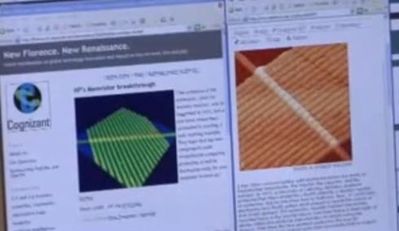 |
“Memristor” could enable computation on memory chips.
Photo: Hewlett Packard Development Company, L.P. |
| |
Memristor
A memristor ("memory resistor") is any of various kinds of passive two-terminal circuit elements that maintain a functional relationship between the time integrals of current and voltage.
This function, called
memristance, is similar to variable resistance.
Specifically engineered memristors provide controllable resistance, but such devices are not commercially available.
Other devices like batteries and varistors have memristance, but it does not normally dominate their behavior.
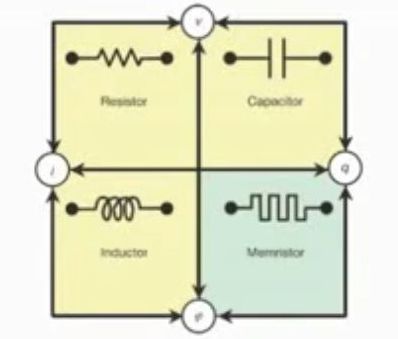 |
The definition of the memristor is based solely on fundamental circuit variables, similarly to the resistor, capacitor, and inductor.
Photo: Hewlett Packard Development Company, L.P. |
| |
The definition of the
memristor is based solely on fundamental circuit variables, similarly to the
resistor, capacitor, and
inductor.
Unlike those three elements, which are allowed in linear time-invariant or
LTI system theory,
memristors are nonlinear and may be described by any of a variety of time-varying functions of net charge.
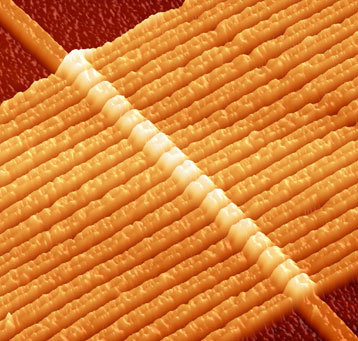 |
Memristor. An array of 17 purpose-built oxygen-depleted titanium dioxide memristors built at HP Labs, imaged by an atomic force microscope. The wires are about 50 nm, or 150 atoms, wide. Electric current through the memristors shifts the oxygen vacancies, causing a gradual and persistent change in electrical resistance.
Photo: Hewlett Packard Development Company, L.P. |
| |
There is no such thing as a
generic memristor.
Instead, each device implements a particular function, wherein either the integral of voltage determines the integral of current, or vice versa.
A linear time-invariant
memristor is simply a conventional resistor.
Memristor theory was formulated and named by
Leon Chua in a 1971 paper.
Chua extrapolated the
conceptual symmetry between the resistor, inductor, and capacitor, and inferred that the
memristor is a similarly fundamental device.
Other scientists had already used fixed nonlinear flux-charge relationships, but
Chua's theory introduces generality.
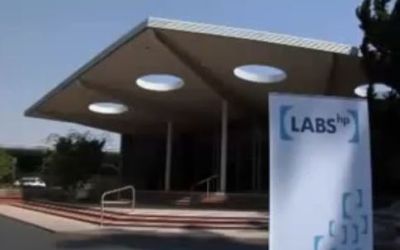 |
|
HP Labs Palo Alto, USA
Photo: Hewlett Packard Development Company, L.P.
|
| |
On April 30, 2008 a
team at HP Labs announced the development of a
switching memristor.
Based on a thin film of
titanium dioxide, it has a regime of operation with an approximately linear charge-resistance relationship.
These devices are being developed for application in
nanoelectronic memories, computer logic, and neuromorphic computer architectures.
PALO ALTO, Calif., April 8, 2010
“Memristor” could enable computation on memory chips
HP today announced advancements in research from
HP Labs – the company’s central research arm – that could change the way computer systems are designed while better equipping them to process the current “
information explosion.”
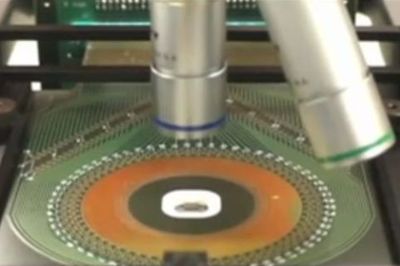 |
| Photo: Hewlett Packard Development Company, L.P. |
| |
HP Labs researchers have discovered that the “
memristor“ –
a resistor with memory that represents the fourth basic circuit element in electrical engineering – has more capabilities than was previously thought.
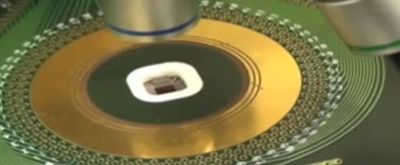 |
| Photo: Hewlett Packard Development Company, L.P. |
| |
In addition to being useful in storage devices, the
memristor can perform logic, enabling computation to one day be performed in chips where data is stored, rather than on a specialized central processing unit.
Highlights
• The latest findings about the memristor are detailed in a paper published this week in the journal “Nature” by six researchers at HP’s Information and Quantum Systems Lab, led by R. Stanley Williams. These developments follow the HP Labs team’s first demonstration of the existence of the memristor in 2008.
• HP has created development-ready architectures for memory chips using memristors and believes it is possible that devices incorporating the element could come to market within the next few years.
• HP researchers also have designed a new architecture within which multiple layers of memristor memory can be stacked on top of each other in a single chip. In five years, such chips could be used to create handheld devices that offer ten times greater embedded memory than exists today or to power supercomputers that allow work like movie rendering and genomic research to be done dramatically faster than Moore’s Law suggests is possible.
• Eventually, memristor-based processors might replace the silicon in the smart display screens found in e-readers and could one day even become the successors to silicon on a larger scale.
Memristor chips and energy use
• Memristors require less energy to operate and are faster than present solid-state storage technologies such as flash memory, and they can store at least twice as much data in the same area.
• Memristors are virtually immune from radiation, which can disrupt transistor-based technologies – making them an attractive way to enable ever smaller but ever more powerful devices.
• Because they do not “forget,” memristors can enable computers that turn on and off like a light switch.
Supporting quotes
“Memristive devices could change the standard paradigm of computing by enabling calculations to be performed in the chips where data is stored rather than in a specialized central processing unit. Thus, we anticipate the ability to make more compact and power-efficient computing systems well into the future, even after it is no longer possible to make transistors smaller via the traditional Moore’s Law approach.”
– R. Stanley Williams, senior fellow and director, Information and Quantum Systems Lab, HP
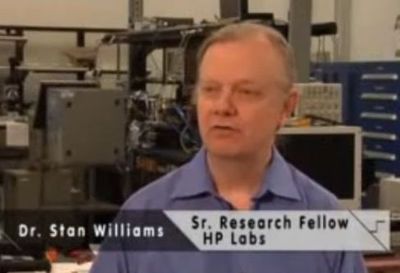 |
R. Stanley Williams, Ph.D. - HP Senior Fellow, Director, Information and Quantum Systems Research Lab, Palo Alto.
Photo: Hewlett Packard Development Company, L.P. |
| |
“Since our brains are made of memristors, the flood gate is now open for commercialization of computers that would compute like human brains, which is totally different from the von Neumann architecture underpinning all digital computers.”
– Leon Chua, professor, Electrical Engineering and Computer Sciences Department, University of California at Berkeley.
Dr. Chua initially theorized about and named the memristor in an academic paper published 39 years ago.
Images and videos
Photo of the memristor:
http://en.wikipedia.org/wiki/File:Memristor.jpg
IEEE Spectrum’s “Six-Minute Memristor Guide”: Stan Williams gives a whiteboard talk about how the memristor works:
http://www.youtube.com/watch?v=rvA5r4LtVnc
“The Next Step in Revolutionary Electronics”: Video about the discovery of the memristor, produced by The Next Step:
http://www.youtube.com/watch?v=wZAHG3COYYA
Links
Article about memristor on the HP Labs website:
http://www.hpl.hp.com/news/2010/apr-jun/memristor.html
FAQ on memristor:
http://www.hpl.hp.com/news/2008/apr-jun/memristor_faq.html
Memristor named one of “Wired” magazine’s “Top Technology Breakthroughs of 2008”:
http://www.wired.com/gadgets/miscellaneous/news/2008/12/YE8-_techbreaks?currentPage=all
About HP
HP creates new possibilities for technology to have a meaningful impact on people, businesses, governments and society.
The world’s largest technology company,
HP brings together a portfolio that spans printing, personal computing, software, services and IT infrastructure to solve customer problems.
More information about
HP (NYSE: HPQ) is available at
http://www.hp.com/
Editorial contacts:
Elisa Greene, HP
elisa.greene@hp.com
http://www.hp.com/hpinfo/newsroom/press/2010/100408xa.html
From Lab to Fab – An HP Labs discovery demonstrates the viability – and versatility – of memristor technology
The HP Labs team that built the world’s first memristor this week announced another significant advance in memristor research.
In an article published in the current issue of
Nature, the
HP researchers demonstrate that memristors – a fourth basic element in integrated circuits which only existed in theory until 2008 – are capable of performing logic functions.
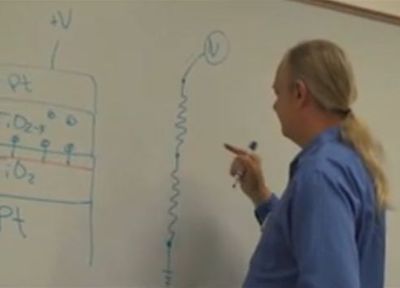 |
R. Stanley Williams, Hewlett-Packard Labs
Photo: Hewlett Packard Development Company, L.P. |
| |
It’s further evidence that memristors have the potential to make an impact on real world computing, says
Stanley Williams, director of HP’s Information & Quantum Systems Lab and lead researcher on the project.
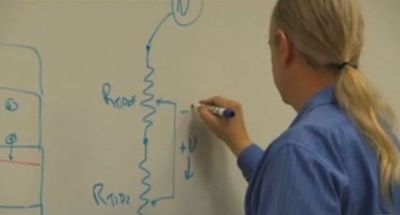 |
R. Stanley Williams, Hewlett-Packard Labs
Photo: Hewlett Packard Development Company, L.P. |
| |
“Our research is now moving out of the lab and towards fabrication of memristor-based circuitry,”
Williams reports.
“And as we’re getting closer to the practical implementation of memristor technology, we’re learning more and more about it.”
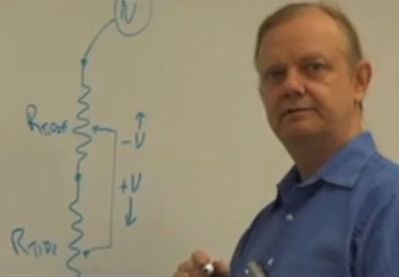 |
R. Stanley Williams, Hewlett-Packard Labs
Photo: Hewlett Packard Development Company, L.P. |
| |
If memristors can perform logic, they might one day be used to create computer processors, suggests
Williams.
And since those processors could be made with industry-standard materials and processes, memristors might help extend Moore’s Law past the point where silicon technology runs up against insurmountable technical barriers, he says.
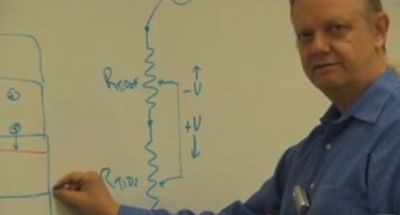 |
R. Stanley Williams, Hewlett-Packard Labs
Photo: Hewlett Packard Development Company, L.P. |
| |
In the much nearer term,
Williams expects to see memristors used in computer memory chips within the next few years.
HP Labs already has a production-ready architecture for such a chip.
Memristor chips require less energy to operate than current alternatives, such as
flash memory.
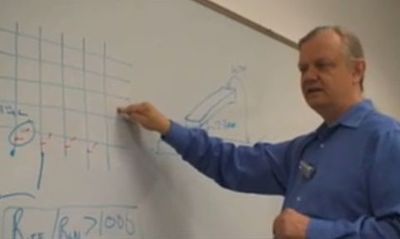 |
R. Stanley Williams, Hewlett-Packard Labs
Photo: Hewlett Packard Development Company, L.P. |
| |
They also store data in approximately half the space required by flash chips and are virtually immune to interference from radiation – making them attractive to any manufacturer looking to create ever-smaller but ever-more-powerful devices.
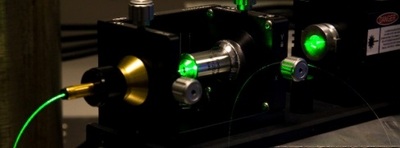 |
| Photo: Hewlett Packard Development Company, L.P. |
| |
In research published last fall,
William’s group suggested how memristor memory could be combined with silicon processors in a multi-dimensional processor framework to create a
hybrid chip that would be significant advance towards the idea of a ‘
computer on a chip.’
| |
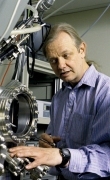 |
| |
R. Stanley Williams, Hewlett-Packard Labs
Photo: HP Labs |
| |
Machines equipped with such processors would be useful for any compute- and memory-intense task, like seismic surveying, animation rendering or space research.
Eventually, memristor-based processors might replace the silicon in the smart display screens found in e-readers, says
Williams, and could one day even become the successors to silicon on a larger scale.
That’s the real significance of the article in this week’s
Nature, he says.
“Memristors are allowing us to think about different ways of doing computing. And we’re only just starting to really understand the long term potential that they have.”
http://www.hpl.hp.com/news/2010/apr-jun/memristor.html
R. Stanley Williams, Ph.D.
HP Senior Fellow, Director, Information and Quantum Systems Research Lab, Palo Alto
 |
|
R. Stanley Williams, Ph.D.
Photo: HP Labs
|
| |
Stan Williams is an HP Senior Fellow and founding director of the Information and Quantum Systems Research Lab at HP Labs, with more than 50 scientists and engineers working in areas of fundamental physical sciences.
He is currently focused on developing technology that supports the concept of
CeNSE: The Central Nervous System for the earth.
The idea is that nanotechnology has the potential to revolutionize human interaction with the earth as profoundly as the Internet has revolutionized personal and business interaction.
Prompted by his exploration of the fundamental limits of information and computing,
Williams recently completed extensive research in nano-electronics and nano-photonics.
For the past 30 years, his primary scientific research has been in the areas of solid-state chemistry and physics and their applications to technology.
This evolved into the areas of nanostructures and chemically assembled materials, with an emphasis on the thermodynamics of size and shape.
Williams has been awarded more than 60 U.S. patents, published more than 300 papers in reviewed scientific journals and presented hundreds of invited plenary, keynote and named lectures at international scientific, technical and business events.
He has received numerous awards for business, scientific and academic achievement. Most recently he received the prestigious 2007
Glenn T. Seaborg Medal awarded by the UCLA Department of Chemistry and Biochemistry.
He was named to the inaugural
Scientific American 50 Top Technology leaders in 2002 and then again in 2005 (the first to be so named twice).
In 2005,
Small Times magazine named the U.S. patent collection
Williams has assembled at HP as the world’s top nanotechnology intellectual property portfolio and in 2000,
MIT’s Technology Review placed one of his patents among the top 5 that “
will transform business and technology.”
Williams received a bachelor of arts in chemical physics in 1974 from Rice University and a Ph.D. in physical chemistry from the
University of California, Berkeley in 1978.
He was a member of technical staff at
AT&T Bell Labs from 1978 to 1980 and a faculty member of the
Chemistry Department at UCLA from 1980 to 1995.
http://www.hpl.hp.com/people/stan_williams/
Video
6-Minute Memristor Guide
http://www.youtube.com/watch?v=rvA5r4LtVnc
Video
THE MEMRISTOR - INCREDIBLE!
http://www.youtube.com/watch?v=wZAHG3COYYA
Video
Memristor and Memristive Systems Symposium (Part 1)
http://www.youtube.com/watch?v=QFdDPzcZwbs&NR=1
Video
Memristor and Memristive Systems Symposium (Part 2)
http://www.youtube.com/watch?v=o9u9o_ToQwM&feature=channel
Video
Memristor and Memristive Systems Symposium (Part 3)
http://www.youtube.com/watch?v=h7cX_m5IKxk&feature=channel
Video
Memristor and Memristive Systems Symposium (Part 4)
http://www.youtube.com/watch?v=PSnC_6U5tKI&feature=related

